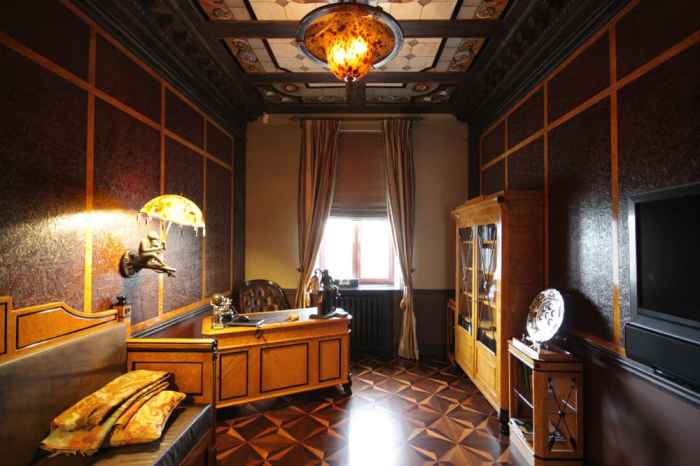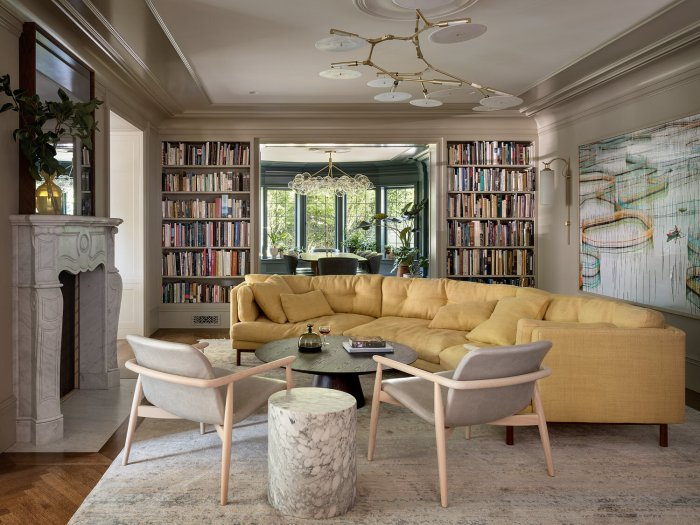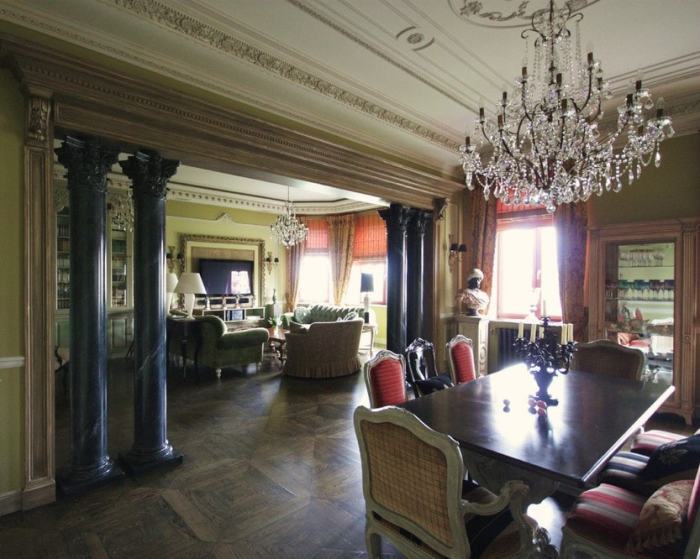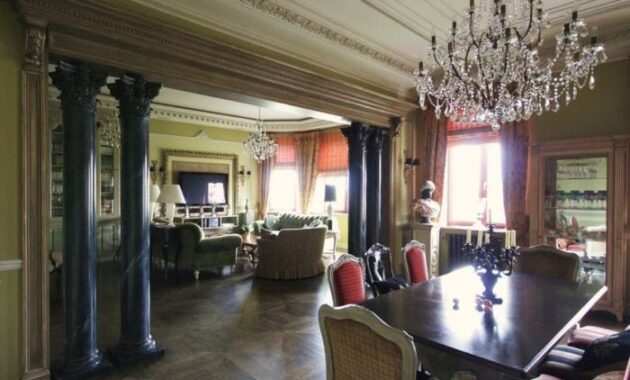1920s house interior design was a vibrant reflection of the era’s social and cultural shifts. As the world emerged from the shadow of World War I, a new era of prosperity and change took hold, inspiring a dramatic transformation in home decor.
The traditional Victorian styles of the past gave way to a more modern, streamlined aesthetic, characterized by geometric patterns, bold colors, and the influence of the burgeoning Art Deco movement. The changing role of women, with their newfound independence and involvement in the workforce, also contributed to the evolving design landscape, as homes became spaces for both functionality and stylish expression.
This period saw the rise of iconic furniture pieces like chaise lounges, club chairs, and cocktail tables, designed for comfort and social interaction. The use of materials like mahogany, lacquer, and chrome added a touch of luxury and sophistication, while rich jewel tones, metallics, and black and white color palettes created a sense of dynamism and excitement.
Lighting played a crucial role in shaping the ambiance, with chandeliers, sconces, and lamps illuminating these stylish spaces. Architectural features like stucco, brick, and geometric shapes added to the overall aesthetic, creating a sense of openness and connection to the outdoors.
Notable 1920s Interior Designers

The 1920s was a transformative decade for interior design, marked by a shift away from the ornate Victorian style and towards a more streamlined, modern aesthetic. This era saw the rise of several influential interior designers who championed this new approach, shaping the evolution of interior design in the 20th century.
Elsie de Wolfe: The Pioneer of Modern Interior Design
Elsie de Wolfe, often referred to as the “first lady of interior design,” played a pivotal role in ushering in a new era of interior design. She rejected the heavy, cluttered Victorian style, advocating for lighter, more functional spaces. De Wolfe’s signature style, characterized by simplicity, elegance, and a focus on comfort, emphasized the use of light colors, natural fabrics, and well-placed furniture.
She believed in creating spaces that were both beautiful and practical, a philosophy that resonated with the changing times.De Wolfe’s most famous project, the Colony Club in New York City, is a prime example of her style. The club, established in 1907, was designed with a focus on comfort and functionality.
It featured a light and airy color palette, simple furniture, and ample natural light, creating a welcoming and sophisticated atmosphere. De Wolfe’s influence extended beyond her own projects. She wrote several books on interior design, including “The House in Good Taste,” which became a bestseller and helped to popularize her approach to decorating.
Syrie Maugham: The Queen of Chic
Syrie Maugham, a British interior designer, was known for her elegant and sophisticated style. She was a master of creating luxurious and inviting spaces, often incorporating elements of the Art Deco movement into her designs. Maugham’s signature style was characterized by the use of rich fabrics, bold colors, and geometric patterns.
She also embraced the use of lacquer, chrome, and other materials that reflected the modern era.One of Maugham’s most famous projects was the renovation of her own London home, which she transformed into a stylish and sophisticated haven. She used a palette of black and white, accented with pops of color, and incorporated sleek, modern furniture.
Maugham’s work was also seen in numerous other projects, including the homes of celebrities and socialites. She became known for her ability to create spaces that were both luxurious and comfortable, reflecting the changing tastes of the 1920s.
1920s House Interior Design in Popular Culture

The 1920s, a period of immense social and cultural change, left an indelible mark on interior design, influencing not only homes but also our collective imagination. This influence is evident in the numerous portrayals of 1920s interior design in movies, television shows, and books, shaping our understanding and appreciation of this iconic era.
Influence of 1920s Interior Design in Popular Culture
The 1920s, a period of immense social and cultural change, left an indelible mark on interior design, influencing not only homes but also our collective imagination. This influence is evident in the numerous portrayals of 1920s interior design in movies, television shows, and books, shaping our understanding and appreciation of this iconic era.
The 1920s saw a shift in interior design, embracing a more modern aesthetic with geometric patterns, Art Deco influences, and a focus on functionality. This era’s design principles can be adapted to modern homes, even smaller spaces like a 1500 sq ft house interior design.
Incorporating elements like bold colors, geometric shapes, and sleek furniture can create a sophisticated and timeless ambiance reminiscent of the Roaring Twenties.
Examples of 1920s Interior Design in Popular Culture
The influence of 1920s interior design in popular culture is undeniable. Movies, television shows, and books often depict this era’s style, showcasing its elegance, glamour, and modernity. These depictions, while not always historically accurate, have shaped public perception of 1920s interior design, contributing to its enduring popularity.
The 1920s saw a surge in Art Deco and Spanish Colonial influences in home design, often featuring geometric patterns, bold colors, and luxurious materials. While these styles are typically associated with larger homes, they can also be adapted to a 1 story house interior design , using smaller-scale furniture and decorative elements to create a similar feel.
A single-story home allows for open floor plans and seamless transitions between living spaces, perfect for incorporating the airy, light-filled aesthetic of 1920s design.
Movies
The cinematic world has provided a rich tapestry of examples showcasing 1920s interior design. From the opulent mansions of “The Great Gatsby” (2013) to the cozy apartments of “The Artist” (2011), movies have brought to life the distinctive features of this era’s style.
Television Shows
Television shows, particularly those set in the 1920s, have also played a significant role in popularizing this era’s interior design. Series like “Boardwalk Empire” (2010-2014) and “The Marvelous Mrs. Maisel” (2017-present) have showcased the lavish interiors of the era, contributing to its enduring appeal.
Books
Literature, too, has contributed to our understanding of 1920s interior design. Books like “The Great Gatsby” by F. Scott Fitzgerald and “The Age of Innocence” by Edith Wharton provide vivid descriptions of the interiors of the era, capturing the essence of its style and its social context.
Popular Movies and TV Shows Featuring 1920s Interior Design, 1920s house interior design
| Movie/TV Show | Year | Description | Key Interior Design Features |
|---|---|---|---|
| The Great Gatsby (2013) | 2013 | A lavish adaptation of F. Scott Fitzgerald’s classic novel, featuring opulent interiors that reflect the decadence of the Roaring Twenties. | Art Deco furniture, geometric patterns, luxurious fabrics, and a vibrant color palette. |
| The Artist (2011) | 2011 | A silent film set in the 1920s, showcasing the interiors of a charming Parisian apartment. | Simple yet elegant furniture, pastel colors, and Art Deco accents. |
| Boardwalk Empire (2010-2014) | 2010-2014 | A historical drama set in Atlantic City during the Prohibition era, featuring lavish interiors that reflect the wealth and extravagance of the time. | Dark wood furniture, ornate chandeliers, and luxurious fabrics. |
| The Marvelous Mrs. Maisel (2017-present) | 2017-present | A comedy-drama set in New York City in the late 1950s, featuring interiors that reflect the changing styles of the era. | Mid-century modern furniture, bright colors, and geometric patterns. |
Creating a 1920s Inspired Interior Today
The Roaring Twenties, a time of jazz, flappers, and Art Deco, left a lasting impression on interior design. While modern homes may not be built in the same style, you can still capture the glamour and sophistication of the era with a few key design elements.
The 1920s saw a shift in house interior design, embracing Art Deco and streamlined aesthetics. While large mansions often showcased these trends, smaller homes also adopted the spirit of the era. For those looking to capture this style in a contemporary setting, exploring design concepts for a 100 sqm house interior design can provide inspiration.
You can incorporate geometric patterns, bold colors, and luxurious materials to create a similar sense of sophistication and glamour in a more compact space.
Furniture Selection
The 1920s saw a shift towards streamlined, geometric shapes, often with a focus on comfort and functionality. When selecting furniture, consider these elements:
- Sofas and Armchairs:Look for pieces with low, curved backs and loose cushions. Velvet, leather, and chenille fabrics were popular choices for upholstery, offering a luxurious feel. Consider a Chesterfield sofa for a classic touch, or a chaise lounge for a touch of elegance.
- Dining Tables and Chairs:Choose tables with rounded edges and simple designs. Chairs with tapered legs and upholstered seats are ideal. Look for materials like walnut or mahogany for a traditional feel.
- Sideboards and Credenzas:These pieces were often crafted from wood with intricate details. They can add a touch of formality to a living room or dining area.
Color Palettes
The 1920s were known for their bold use of color. However, it’s not necessary to go overboard. Start with a neutral base, like beige or cream, and add pops of color through accessories and upholstery.
- Neutral Base:A neutral base provides a backdrop for bolder colors and patterns. Consider using a light beige or cream for walls, and a darker shade for trim.
- Bold Accents:Incorporate rich colors like emerald green, ruby red, sapphire blue, and gold. These can be used in throw pillows, rugs, and artwork.
- Metallic Finishes:Gold, silver, and brass accents were popular in the 1920s. Look for these finishes in lighting fixtures, furniture hardware, and decorative objects.
Accessories
Accessories can add a touch of personality and history to your 1920s-inspired space. Consider these options:
- Art Deco Prints:Geometric patterns, bold colors, and stylized figures are hallmarks of Art Deco. Look for prints featuring these elements, or create your own with stencils and paint.
- Vases and Sculptures:Choose pieces with clean lines and geometric shapes. Look for materials like ceramic, glass, or metal.
- Lighting:Chandeliers with crystal accents, sconces with geometric designs, and table lamps with silk shades are all great choices for adding a touch of 1920s glamour.
Achieving a Vintage Feel
While you don’t want to sacrifice modern comfort, you can still incorporate vintage elements into your design.
- Repurposed Furniture:Look for vintage furniture at flea markets, antique shops, and online marketplaces. You can reupholster pieces to give them a fresh look, or leave them as is for a more authentic feel.
- Vintage Textiles:Incorporate vintage fabrics like velvet, chenille, and silk into your design. These can be used for throw pillows, curtains, or upholstery.
- Antique Accessories:Add a touch of history with vintage accessories like clocks, mirrors, and picture frames. You can also find vintage books, magazines, and other decorative items to create a sense of time.
Wrap-Up: 1920s House Interior Design

The 1920s interior design movement continues to inspire modern designers, offering a timeless blend of elegance, functionality, and artistic expression. From the bold colors and geometric patterns to the iconic furniture pieces and the focus on creating a welcoming and stylish environment, the legacy of the Roaring Twenties lives on in contemporary homes, reminding us of the enduring power of design to reflect the spirit of its time.
General Inquiries
What are some common 1920s design elements that can be incorporated into modern homes?
You can bring a touch of 1920s style to your home with geometric patterns, bold colors, and streamlined furniture. Consider using a black and white color palette with pops of rich jewel tones, incorporating geometric rugs and wallpaper, and incorporating vintage furniture pieces like a chaise lounge or club chairs.
How can I achieve a vintage feel without sacrificing modern comfort and functionality?
You can create a vintage aesthetic without sacrificing modern comfort by selecting furniture with a timeless design and incorporating vintage elements like antique rugs, lamps, and decorative accessories. You can also use modern materials in a vintage-inspired way, such as using chrome accents on furniture or incorporating geometric patterns in upholstery.
Are there any specific resources for finding 1920s furniture and decor?
Antique shops, flea markets, and online marketplaces are great resources for finding authentic 1920s furniture and decor. You can also find reproduction pieces that capture the essence of the era’s style.

